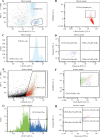Functional activity of natural killer cells in biological fluids in patients with colorectal and ovarian cancers
- PMID: 29736145
- PMCID: PMC5927170
- DOI: 10.5114/ceji.2018.74870
Functional activity of natural killer cells in biological fluids in patients with colorectal and ovarian cancers
Abstract
Aim of the study: To compare the functional activity of natural killer cells depending on the presence of a malignant process and its dissemination.
Material and methods: The study included 20 patients with Stage IIIB, C (FIGO, 2009) ovarian cancer, 10 patients with benign ovarian tumours (BOT), and 20 patients with colorectal cancer (T2-4N0-2M0). The control group consisted of 9 healthy donors. To evaluate the number and functional activity of NK cells, multicolour flow cytometry was performed.
Results: In cancer patients, the relative number of activated NK cells secreting granzyme B (GB) (CD56+CD107a+GB+PF-) was significantly decreased, and the proportion of degranulated NK cells (CD56+CD107a+GB-PF-) was significantly increased, compared to those observed in healthy donors. The total number of NK cells in peripheral blood was low in ovarian cancer patients (p < 0.05). The proportion of activated peripheral blood NK cells containing cytolytic granules GB and perforin (PF) in colorectal cancer patients increased with tumour growth. However, lymph node metastasis did not affect the content and activation of NK cells. Comparative analysis of NK-cell populations in patients with benign and malignant ovarian tumours revealed that the level of CD56+ cells was significantly higher in ascites than in peripheral blood. However, CD56+CD107a+ activated cells and CD56+CD107a+GB+PF+ cells were found more frequently in ascites of BOT patients than in ovarian cancer patients. The degranulated population of NK cells (CD56+CD107a+GB-PF-) was mainly observed in the peripheral blood of ovarian cancer patients.
Keywords: Colorectal cancer; ascites; functional activity; natural killer cells; ovarian cancer; peripheral blood.
Conflict of interest statement
The authors declare no conflict of interests.
Figures

Similar articles
-
Impaired circulating CD56dim NK cells are associated with decompensation of HBV-related cirrhosis.Hum Immunol. 2020 Jan;81(1):32-40. doi: 10.1016/j.humimm.2019.11.006. Epub 2019 Nov 14. Hum Immunol. 2020. PMID: 31735440 Clinical Trial.
-
Ex vivo expansion of CD56+ NK and NKT-like lymphocytes from peripheral blood mononuclear cells of patients with ovarian neoplasia.Scand J Immunol. 2011 Sep;74(3):244-252. doi: 10.1111/j.1365-3083.2011.02576.x. Scand J Immunol. 2011. PMID: 21595734
-
Peritoneal natural killer cells from epithelial ovarian cancer patients show an altered phenotype and bind to the tumour marker MUC16 (CA125).Immunology. 2007 Nov;122(3):418-29. doi: 10.1111/j.1365-2567.2007.02660.x. Epub 2007 Jul 6. Immunology. 2007. PMID: 17617155 Free PMC article.
-
Cytotoxic Function and Cytokine Production of Natural Killer Cells and Natural Killer T-Like Cells in Systemic Lupus Erythematosis Regulation with Interleukin-15.Mediators Inflamm. 2019 Mar 31;2019:4236562. doi: 10.1155/2019/4236562. eCollection 2019. Mediators Inflamm. 2019. PMID: 31049024 Free PMC article.
-
CD16- natural killer cells: enrichment in mucosal and secondary lymphoid tissues and altered function during chronic SIV infection.Blood. 2010 Jun 3;115(22):4439-46. doi: 10.1182/blood-2010-01-265595. Epub 2010 Mar 25. Blood. 2010. PMID: 20339088 Free PMC article.
Cited by
-
Exploring the Potential of Natural Killer Cell-Based Immunotherapy in Targeting High-Grade Serous Ovarian Carcinomas.Vaccines (Basel). 2024 Jun 18;12(6):677. doi: 10.3390/vaccines12060677. Vaccines (Basel). 2024. PMID: 38932405 Free PMC article. Review.
-
Diagnostic Efficacy and Clinical Significance of Lymphocyte Subsets, Granzyme B and Perforin in the Peripheral Blood of Patients with Invasive Breast Cancer Following Neoadjuvant Chemotherapy.Cancer Manag Res. 2025 Mar 17;17:589-602. doi: 10.2147/CMAR.S502155. eCollection 2025. Cancer Manag Res. 2025. PMID: 40124841 Free PMC article.
-
Preclinical and Clinical Immunotherapeutic Strategies in Epithelial Ovarian Cancer.Cancers (Basel). 2020 Jul 2;12(7):1761. doi: 10.3390/cancers12071761. Cancers (Basel). 2020. PMID: 32630708 Free PMC article. Review.
-
Altered intraperitoneal immune microenvironment in patients with peritoneal metastases from gastric cancer.Front Immunol. 2022 Sep 2;13:969468. doi: 10.3389/fimmu.2022.969468. eCollection 2022. Front Immunol. 2022. PMID: 36119051 Free PMC article.
-
Enhancing the therapeutic efficacy of NK cells in the treatment of ovarian cancer (Review).Oncol Rep. 2024 Mar;51(3):50. doi: 10.3892/or.2024.8709. Epub 2024 Feb 1. Oncol Rep. 2024. PMID: 38299257 Free PMC article. Review.
References
-
- Apetoh L, Obeid M, Tesniere A, et al. Immunogenic chemotherapy: discovery of a critical protein through proteomic analyses of tumor cells. Cancer Genomics Proteomics. 2007;4:65–70. - PubMed
-
- Hannani D, Sistigu A, Kepp O, et al. Prerequisites for the antitumor vaccine-like effect of chemotherapy and radiotherapy. Cancer J. 2011;17:351–358. - PubMed
-
- Stakheeva MN, Kzhyshkowska YG, Buldakov MA, et al. Mechanisms of immune system contribution to efficiency of antitumor cytostatic therapy. Vopr Onkol. 2015;61:546–55. - PubMed
LinkOut - more resources
Full Text Sources
Other Literature Sources
Research Materials
